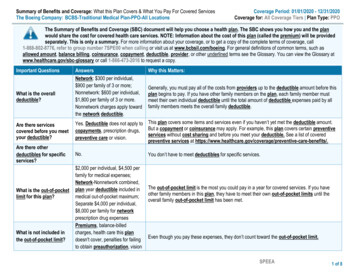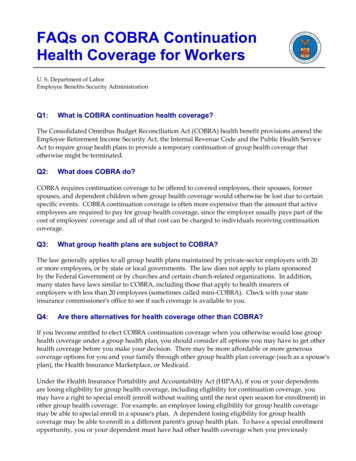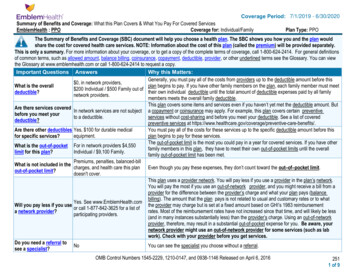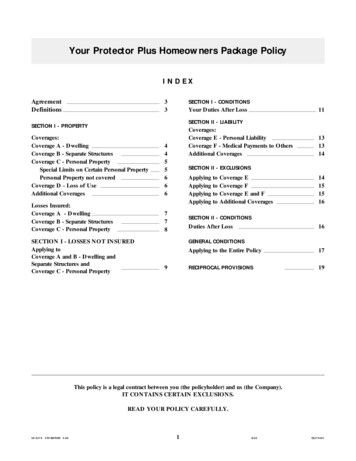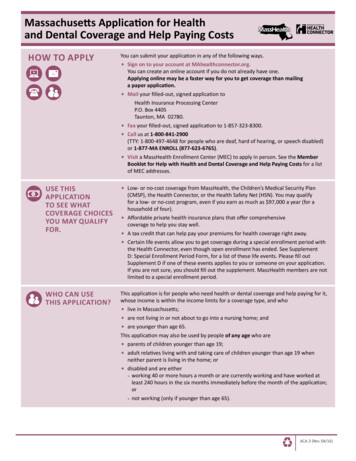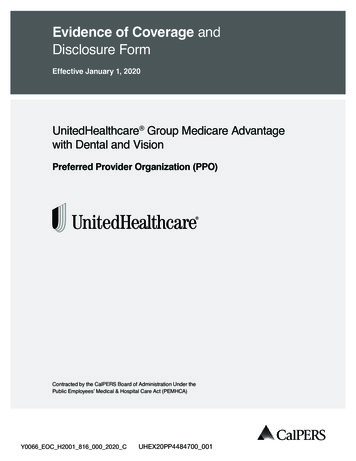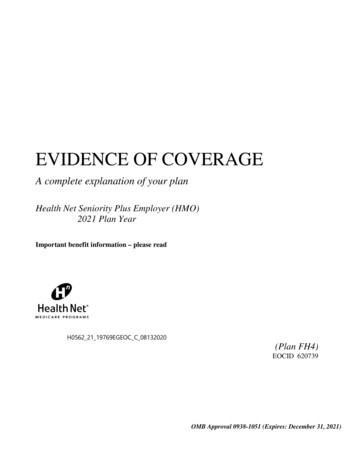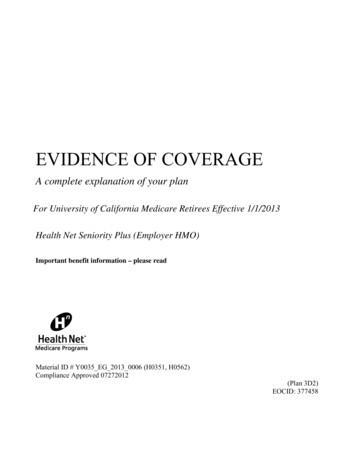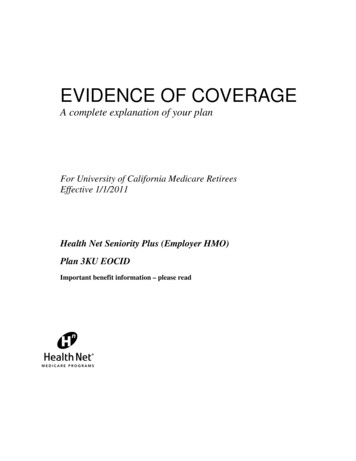
Transcription
EVIDENCE OF COVERAGEA complete explanation of your planFor University of California Medicare RetireesEffective 1/1/2011Health Net Seniority Plus (Employer HMO)Plan 3KU EOCIDImportant benefit information – please read
Schedule changes in 2011This page is not an official statement of benefits. Your benefits are describedin detail in the Evidence of Coverage. We have also edited and clarifiedlanguage throughout the Evidence of Coverage in addition to the items listedbelow.Changes to this PlanOut of Pocket Maximum - Services which are covered underMedicare Part A & B apply to the 1500 per member annual copaymentmaximum (see Section 12 , Chapter 7).Out of Pocket Maximum - Services that are covered underMedicare Part D apply to the 2,000 per person per calendar year annualprescription drug out-of-pocket maximumUrgent Care service copayment - The Urgent Carecopayment has been changed from 50 to 15.Medical Inpatient, Substance Abuse Inpatient,Mental Health Inpatient, and DetoxificationInpatient - Under the “Schedule of Benefits” The 250 limit to firstthree inpatient admissions per calendar year has been removed.CVS Mail Order Pharmacy Chapter 8 Section 2.3, Mail ordercan be filled for one month, two months, or three months supply forMedicare members. CVS will charge one month supply for 31 day supplyand 2x retail copayment for mail order of 60 day supply or more. In 2010CVS did not dispense a 34-day or less mail order. Full mail order copay 2xretail was charged to any quantity amount ordered and filed for 34-days ormore.Glaucoma tests The copayment for Glaucoma testing has beenchanged from 15 to 0 (see chapter 3, “Plan benefit chart.”)Note:Once you enroll in Medicare, your behavioral health provider network willbe different and you will need to obtain new authorizations/self referrals tobehavioral health providers. Please review your Health Net ID card for theappropriate phone number for Mental Health and Substance Abuse.
Table of ContentsThis list of chapters and page numbers is just your starting point. For more help infinding information you need, go to the first page of a chapter. You will find adetailed list of topics at the beginning of each chapter.Chapter 1.University of California - Eligibility, Enrollment, Termination andPlan Administration Provisions .1Chapter 2.Your Evidence of Coverage.14Chapter 3.Plan benefits chart.15Chapter 4.Getting started as a member of our plan .60Chapter 5.Important phone numbers and resources .70Chapter 6.Using the plan’s coverage for your medical services .85Chapter 7.Medical Benefits Chart (what is covered and what you pay) .97Chapter 8.Using the plan’s coverage for your Part D prescription drugs.103Chapter 9.What you pay for your Part D prescription drugs.120Chapter 10. Asking the plan to pay its share of a bill you have received for coveredservices or drugs .138Chapter 11. Your rights and responsibilities.144Chapter 12. What to do if you have a problem or complaint (coverage decisions, appeals,complaints).158Chapter 13. Ending your membership in the plan .211Chapter 14. Legal notices .220Chapter 15. Definitions of important words .227Explains key terms used in this booklet.
2011 Evidence of Coverage for Health Net Seniority Plus (Employer HMO)1Chapter 1. University of California - Eligibility, Enrollment,Termination and Plan Administration ProvisionsUNIVERSITY OF CALIFORNIA ELIGIBILITY, ENROLLMENT,TERMINATION AND PLAN ADMINISTRATION PROVISIONSJanuary 1, 2011The following information applies to the University of California plan and supersedes anycorresponding information that may be contained elsewhere in the document to which this insertis attached. The University establishes its own medical plan eligibility, enrollment andtermination criteria based on the University of California Group Insurance Regulations("Regulations") and any corresponding Administrative Supplements. Portions of theseRegulations are summarized below.ELIGIBILITYThe following individuals are eligible to enroll in this Plan. If the Plan is a Health MaintenanceOrganization (HMO) or Exclusive Provider Organization (EPO) Plan, they are only eligible toenroll in the Plan if they meet the Plan's geographic service area criteria. Anyone enrolled in anon-University Medicare Advantage Managed Care contract or enrolled in a non-UniversityMedicare Part D Prescription Drug Plan will be deenrolled from this health plan.SubscriberEmployee:You are eligible if you are appointed to work at least 50% time for twelve monthsor more or are appointed at 100% time for three months or more or haveaccumulated 1,000* hours while on pay status in a twelve-month period. Toremain eligible, you must maintain an average regular paid time** of at least 17.5hours per week and continue in an eligible appointment. If your appointment is atleast 50% time, your appointment form may refer to the time period as follows:"Ending date for funding purposes only; intent of appointment is indefinite (formore than one year)."* Lecturers - see your benefits office for eligibility.** Average Regular Paid Time - For any month, the average number of regularpaid hours per week (excluding overtime, stipend or bonus time) worked in thepreceding twelve (12) month period. Average regular paid time does notinclude full or partial months of zero paid hours when an employee works lessthan 43.75% of the regular paid hours available in the month due to furlough,leave without pay or initial employment.Retiree:A former University Employee receiving monthly benefits from a Universitysponsored defined benefit plan.You may continue University medical plan coverage as a Retiree when you startcollecting retirement or disability benefits from a University-sponsored definedbenefit Plan provided that you must also meet the following requirements:(a) you meet the University's service credit requirements for Retiree medicaleligibility;
2011 Evidence of Coverage for Health Net Seniority Plus (Employer HMO)2(b) the effective date of your Retiree status is within 120 calendar days of the dateemployment ends; and(c) you elect to continue (or effective 1/1/05 suspend) medical coverage at thetime of retirement.A Survivor a deceased Employee's or Retiree's Family Member receivingmonthly benefits from a University-sponsored defined benefit plan—may beeligible to continue coverage as set forth in the University’s Group InsuranceRegulations. For more information, see the UC Group Insurance EligibilityFactsheet for Retirees and Eligible Family Members or the Survivor andBeneficiary Handbook.If you are eligible for Medicare, you must follow UC’s Medicare Rules. See"Effect of Medicare on Retiree Enrollment" below.Eligible Dependents (Family Members)When you enroll any Family Member, your signature on the enrollment form or the confirmationnumber on your electronic enrollment attests that your Family Member meets the eligibilityrequirements outlined below. The University and/or the Plan reserves the right to periodicallyrequest documentation to verify eligibility of Family Members, including any who are requiredto be your tax dependent(s). Documentation could include a marriage certificate, birthcertificate(s), domestic partner verification, adoption records, Federal Income Tax Return, orother official documentation.Eligible Adult:Spouse: Your legal spouse.Same Sex-Domestic Partner: You may enroll a same-sex domestic partner (andthe same-sex domestic partner's children/grandchildren) as set forth in theUniversity of California Group Insurance Regulations.Opposite-Sex Domestic Partner: The University recognizes an opposite-sexdomestic partner as a family member that is eligible for coverage in UCsponsored benefits if the employee/retiree or domestic partner is age 62 or olderand eligible to receive Social Security benefits and both the employee/retiree anddomestic partner are at least 18 years of age.Note: An adult dependent relative is no longer eligible for coverage. Only anadult dependent relative who was enrolled as an eligible dependent as ofDecember 31, 2003 and continues to be ineligible for Medicare Part A maycontinue coverage in UC-sponsored plans.Child:All eligible children must be under the limiting age of 26 (18 for legal wardsexcept for a child who is incapable of self-support due to a physical or mentallydisabling injury, illness or condition). The following categories are eligible:(a) your natural or legally adopted children;(b) your spouse’s natural or legally adopted children (your stepchildren);(c) your eligible domestic partner’s natural or legally adopted children;
2011 Evidence of Coverage for Health Net Seniority Plus (Employer HMO)3(d) grandchildren of you, your spouse or your eligible domestic partner if livingwith you, dependent on you, your spouse or your eligible domestic partner forat least 50% of their support and are your, your spouse's, or your eligibledomestic partner’s dependents for income tax purposes;(e) children for whom you are the legal guardian if living with you, dependent onyou for at least 50% of their support and are your dependents for income taxpurposes.(f) children for whom you are legally required to provide group health insurancepursuant to an administrative or court order. (Child must also meet UCeligibility requirements.)Any child described above (except a legal ward) who is incapable of self-supportdue to a physical or mental disability may continue to be covered past age 26provided:- the plan-certified disability began before age 26, the child was enrolled in aUC group medical plan before age 26 and coverage is continuous;- the child is chiefly dependent upon you, your spouse, or your eligibledomestic partner’s for support and maintenance; and- the child is claimed as your, your spouse, or your eligible domestic partner’sdependent for income tax purposes, or if not claimed as such dependent forincome tax purposes, is eligible for Social Security Income or SupplementalSecurity Income as a disabled person or working in supported employmentwhich may offset the Social Security or Supplemental Security Income.Application for coverage beyond age 26 due to disability must be made to thePlan sixty days prior to the date coverage is to end due to reaching limiting age. Ifapplication is received timely but Plan does not complete determination of thechild’s continuing eligibility by the date the child reaches the Plan’s upper agelimit, the child will remain covered pending Plan’s determination. The Plan mayperiodically request proof of continued disability, but not more than once a yearafter the initial certification. Disabled children approved for continued coverageunder a University-sponsored medical plan are eligible for continued coverageunder any other University-sponsored medical plan; if enrollment is transferredfrom one plan to another, a new application for continued coverage is notrequired; however, the new Plan may require proof of continued disability, but notmore than once a year.If you are a newly hired Employee with a disabled child over age 26 or if younewly acquire a disabled child over age 26 (through marriage or adoption), youmay also apply for coverage for that child. The child’s disability must have begunprior to the child turning age 26. Additionally, the child must have hadcontinuous group medical coverage since age 26, and you must apply forUniversity coverage during your Period of Initial Eligibility. The Plan will ask forproof of continued disability,, but not more than once a year after the initialcertification.Important Note: Health and welfare benefits and eligibility requirements,including dependent eligibility requirements are subject to change (e.g., forcompliance with applicable laws and regulations). UC dependent eligibility
2011 Evidence of Coverage for Health Net Seniority Plus (Employer HMO)4requirements may change following final health care reform legislation,regulatory guidance, or other applicable laws.No Dual CoverageEligible individuals may be covered under only one of the following categories: as anEmployee, a Retiree, a Survivor or a Family Member. If an Employee and the Employee’sspouse or domestic partner are both eligible Subscribers, each may enroll separately or one mayenroll and cover the other as a Family Member. If they enroll separately, neither may enroll theother as a Family Member. Eligible children may be enrolled under either parent's or eligibledomestic partner’s coverage but not under both. Additionally, a child who is also eligible as anEmployee may not have dual coverage through two University-sponsored medical plans.More InformationFor information on who qualifies and how to enroll, contact your local Benefits Office or theUniversity of California's (UC) Customer Service Center at (800) 888-8267. You may alsoaccess eligibility factsheets on UC’s At Your Service web site: http://atyourservice.ucop.edu.ENROLLMENTFor information about enrolling yourself or an eligible Family Member, see the person at yourlocation who handles benefits. If you are a Retiree, contact the UC Customer Service Center.Enrollment transactions may be completed by paper form or electronically, according to currentUniversity practice. To complete the enrollment transaction, paper forms must be received bythe local Accounting or Benefits office or by the UC Customer Service Center by the lastbusiness day within the applicable enrollment period. Electronic transactions must be completedby the deadline on the last day of the enrollment period.During a Period of Initial Eligibility (PIE)A PIE begins the day you become eligible and ends 31 days after it began (but see exceptionunder “Special Circumstances” paragraph 1.d below). Also see “At Other Times for Employeesand Retirees” below. If the last day of a PIE falls on a weekend or holiday, the PIE is extended tothe following business day when enrolling with forms.If you are an Employee, you may enroll yourself and any eligible Family Members during yourPIE. Your PIE starts the day you become an eligible Employee.You may enroll any newly eligible Family Member during his or her PIE. The Family Member'sPIE starts the day your Family Member becomes eligible, as described below. During this PIEyou may also enroll yourself and/or any other eligible Family Member if not enrolled duringyour own or their own PIE. You must enroll yourself in order to enroll any eligible FamilyMember. Family members are only eligible for the same plan in which you are enrolled.(a) For a spouse, on the date of marriage.(b) For a Domestic Partner, on the date the domestic partnership is legally established. Alsosee “At Other Times for Employees and Retirees” below.
2011 Evidence of Coverage for Health Net Seniority Plus (Employer HMO)5(c) For a natural child, on the child's date of birth.(d) For an adopted child, the earlier of:(i) the date the child is placed for adoption with the Employee/Retiree, or(ii) the date the Employee/Retiree or Spouse/Domestic Partner has the legal right tocontrol the child’s health care.A child is “placed for adoption” with the Employee/Retiree as of the date theEmployee/Retiree assumes and retains a legal obligation for the child’s total or partialsupport in anticipation of the child’s adoption.If the child is not enrolled during the PIE beginning on that date, there is an additionalPIE beginning on the date the adoption becomes final.(e) Where there is more than one eligibility requirement, the date all requirements aresatisfied.If you are in a Health Maintenance Organization (HMO), Exclusive Provider Organization(EPO), or Point of Service (POS) Plan and you move or are transferred out of that Plan’s servicearea, or will be away from the Plan’s service area for more than two months, you will have a PIEto enroll yourself and your eligible Family Members in another University medical planavailable in the new location. Your PIE starts with the effective date of the move or the date youleave the Plan’s service area. Upon return to the service area, you will have a PIE to reenrollyourself and eligible Family Members in the same HMO, EPO or POS you had at the time of themove out of the area. The PIE begins with the effective date of the return to the service area.At Other Times for Employees and RetireesGroup Open Enrollment Period. You and your eligible Family Members may also enrollduring a group open enrollment period established by the University.90-Day Waiting Period. If you are an Employee and opt out of medical coverage or fail toenroll yourself during a PIE or open enrollment period, you may enroll yourself at any other timeupon completion of a 90 consecutive calendar day waiting period unless one of the “SpecialCircumstances” described below applies.If you are an Employee or Retiree and fail to enroll your eligible Family Members during a PIEor open enrollment period, you may enroll your eligible Family Members at any other time uponcompletion of a 90 consecutive calendar day waiting period unless one of the “SpecialCircumstances” described below applies.The 90-day waiting period starts on the date the enrollment form is received by the localAccounting or Benefits office and ends 90 consecutive calendar days later.Newly Eligible Child. If you have one or more children enrolled in the Plan, you may add anewly eligible Child at any time. See "Effective Date".
2011 Evidence of Coverage for Health Net Seniority Plus (Employer HMO)6Special Circumstances. You may enroll before the end of the 90-day waiting period or withoutwaiting for the University’s next open enrollment period if you are otherwise eligible under anyone of the circumstances set forth below:1. You have met all of the following requirements:a. You were covered under another health plan as an individual or dependent, includingcoverage under COBRA or CalCOBRA (or similar program in another state), theChildren’s Health Insurance Program or “CHIP” (called the Healthy Families Program inCalifornia), or Medicaid (called Medi-Cal in California).b. You stated at the time you became eligible for coverage under this Plan that you weredeclining coverage under this Plan or disenrolling because you were covered underanother health plan as stated above.c. Your coverage under the other health plan wherein you or your eligible Family Memberswere covered as an individual or dependent ended because you lost eligibility under theother plan or employer contributions toward coverage under the other plan terminated,your coverage under COBRA or CalCOBRA continuation was exhausted, or you lostcoverage under CHIP or Medicaid because you were no longer eligible for thoseprograms.d. You properly file an application with the University during the PIE which starts on theday after the other coverage ends. Note that if you lose coverage under CHIP orMedicaid, your PIE is 60 days.2. You or your eligible Family Members are not currently enrolled and you or your eligibleFamily Members become eligible for premium assistance under the Medi-Cal HealthInsurance Premium Payment (HIPP) Program or a Medicaid or CHIP premium assistanceprogram in another state. Your PIE is 60 days from the date you are determined eligible forpremium assistance. If the last day of the PIE falls on a weekend or holiday, the PIE isextended to the following business day. Electronic transactions must be completed by thedeadline on the last day of the enrollment period.3. A court has ordered coverage be provided for a spouse, domestic partner or dependent childunder your UC-sponsored medical plan and an application is filed within the PIE whichbegins the date the court order is issued. (Family member(s) must also meet UC eligibilityrequirements.)4. You have a change in family status through marriage or domestic partnership, or the birth,adoption, or placement for adoption of a child:a. If you are enrolling following marriage or establishment of a domestic partnership, youand your new spouse or domestic partner must enroll during the PIE. Your new spouseor domestic partner’s eligible children may also enroll at that time. Coverage will beeffective as of the date of marriage or domestic partnership provided you enroll duringthe PIE.b. If you are enrolling following the birth, adoption, or placement for adoption of a child,your spouse or domestic partner, who is eligible but not enrolled, may also enroll at thattime. Application must be made during the PIE; coverage will be effective as of the dateof birth, adoption, or placement for adoption provided you enroll during the PIE.
2011 Evidence of Coverage for Health Net Seniority Plus (Employer HMO)75. You meet or exceed a lifetime limit on all benefits under another health plan. Applicationmust be made within 31 days of the date a claim or a portion of a claim is denied due to yourmeeting or exceeding the lifetime limit on all benefits under the other plan. Coverage will beeffective on the first day of the month following the date you file the enrollment application.If you are an Employee or a Retiree and there is a lifetime maximum for all benefits under thisplan, and you or a Family Member reaches that maximum, you and your eligible FamilyMembers may be eligible to enroll in another UC-sponsored medical plan. Contact the personwho handles benefits at your location (or the UC Customer Service Center if you are a Retiree).If you are a Retiree, you may continue coverage for yourself and your enrolled Family Membersin the same plan (or its Medicare version) you were enrolled in immediately before retiring, andyou may change your plan during the University’s next open enrollment period. You must electto continue enrollment for yourself and enrolled Family Members before the effective date ofretirement (or the date disability or survivor benefits begin). Retirement alone does not grant aPIE to enroll or change your medical plan.If you are a Survivor, you may not enroll your legal spouse or domestic partner.Effective DateThe following effective dates apply provided the appropriate enrollment transaction (paper formor electronic) has been completed within the applicable enrollment period.If you enroll during a PIE, coverage for you and your Family Members is effective the date thePIE starts.If you are a Retiree continuing enrollment in conjunction with retirement, coverage for you andyour Family Members is effective on the first of the month following the first full calendarmonth of retirement income.The effective date of coverage for enrollment during an open enrollment period is the dateannounced by the University.For enrollees who complete a 90-day waiting period, coverage is effective on the 91stconsecutive calendar day after the date the enrollment transaction is completed.An Employee or Retiree already enrolled in adult plus child(ren) or family coverage may addadditional children, if eligible, at any time after their PIE. Retroactive coverage is limited to thelater of:(a) the date the Child becomes eligible, or(b) a maximum of 60 days prior to the date your Child’s enrollment form is received byyour local Benefits or Payroll Office.Change in CoverageIn order to make any of the changes described above, contact the person who handles benefits atyour location (or the UC Customer Service Center if you are a Retiree).
2011 Evidence of Coverage for Health Net Seniority Plus (Employer HMO)8Effect of Medicare on Retiree EnrollmentIf you are a Retiree and you and/or an enrolled Family Member is or becomes eligible forpremium-free Medicare Part A (Hospital Insurance) as primary coverage, then that individualmust also enroll in and remain in Medicare Part B (Medical Insurance). Once Medicarecoverage is established, coverage in both Part A and Part B must be continuous. This includesanyone who is entitled to Medicare benefits through their own or their spouse's employment.Individuals enrolled in both Part A and Part B are then eligible for the Medicare premiumapplicable to this plan.Retirees or their Family Member(s) who become eligible for premium-free Medicare Part A onor afterJanuary 1, 2004 and do not enroll in Part B will permanently lose their UC-sponsored medicalcoverage.Retirees and their Family Members who were eligible for premium-free Medicare Part Abetween July 1, 1991 and January 1, 2004, but declined to enroll in Part B of Medicare, areassessed a monthly offset fee by the University to cover increased costs. The offset fee mayincrease annually, but will stop when the Retiree or Family Member becomes covered under PartB.Retirees or Family Members who are not eligible for premium-free Part A will not be required toenroll in Part B, they will not be assessed an offset fee, nor will they lose their UC-sponsoredmedical coverage. Documentation attesting to their ineligibility for Medicare Part A will berequired. (Retirees/Family Members who are not entitled to Social Security and premium-freeMedicare Part A will not be required to enroll in Part B.)An exception to the above rules applies to Retirees or Family Members in the followingcategories who will be eligible for the non-Medicare premium applicable to this plan and willalso be eligible for the benefits of this plan without regard to Medicare:a) Individuals who were eligible for premium-free Part A, but not enrolled in Medicare PartBprior to July 1, 1991.b) Individuals who are not eligible for premium-free Part A.You should contact Social Security three months before your or your Family Member's 65thbirthday to inquire about your eligibility and how to enroll in Part A and Part B of Medicare. Ifyou qualify for disability income benefits from Social Security, contact a Social Security officefor information about when you will be eligible for Medicare enrollment.Upon Medicare eligibility, you or your Family Member must complete a University of CaliforniaMedicare Declaration form, as well as submit a copy of your Medicare card. This notifies theUniversity that you are covered by Part A and Part B of Medicare. The University's MedicareDeclaration form is available through the UC Customer Service Center or from the web site:http://atyourservice.ucop.edu. Completed forms should be returned to University of California,Human Resources, Retiree Insurance Program, Post Office Box 24570, Oakland, CA 946231570.
2011 Evidence of Coverage for Health Net Seniority Plus (Employer HMO)9Any individual enrolled in a University-sponsored Medicare Advantage Managed Care contractmust assign his/her Medicare benefit (including Part D) to that plan or lose UC-sponsored medicalcoverage. Anyone enrolled concurrently in a non-University Medicare Advantage Managed Carecontract will be deenrolled from this health plan. Any individual enrolled in a Universitysponsored Medicare Part D Prescription Drug Plan must assign his/her Part D benefit to the plan orlose UC-sponsored medical coverage. Anyone enrolled concurrently in a non-University MedicarePart D Prescription Drug Plan will be deenrolled from this health plan.Medicare Secondary Payer Law (MSP)The Medicare Secondary Payer (MSP) Law affects the order in which claims are paid byMedicare and an employer group health plan. Employees or their spouses, age 65 or over, andUC Retirees re-hired into positions making them eligible for UC-sponsored medical coverage,including CORE and mid-level benefits, are subject to MSP. For those eligible for a grouphealth plan due to employment, MSP indicates that Medicare becomes the secondary payer andthe employer plan becomes the primary payer. You and your spouse should carefully considerthe impact on your health benefits and premiums at age 65 or should you decide to return towork after you retire. Continued employment past age 65 may delay enrollment into Part B,however, once enrolled, Part B must be continuous.Medicare Private Contracting Provision and Providers Who do Not Accept MedicareFederal Legislation allows physicians or practitioners to opt out of Medicare. Medicarebeneficiaries wishing to continue to obtain services (that would otherwise be covered byMedicare) from these physicians or practitioners will need to enter into written "privatecontracts" with these physicians or practitioners. These private agreements will require thebeneficiary to be responsible for all payments to such medical providers. Since servicesprovided under such "private contracts" are not covered by Medicare or this Plan, the Medicarelimiting charge will not apply.Some physicians or practitioners have never participated in Medicare. Their services (thatwould be covered by Medicare if they participated) will not be covered by Medicare or this Plan,and the Medicare limiting charge will not apply.If you are classified as a Retiree by the University (or otherwise have Medicare as a primarycoverage), are enrolled in Medicare Part B, and choose to enter into such a "private contract"arrangement as described above wit
2011 Evidence of Coverage for Health Net Seniority Plus (Employer HMO) 4 requirements may change following final health care reform legislation, regulatory guidance, or other applicable laws. No Dual Coverage Eligible individuals may be
